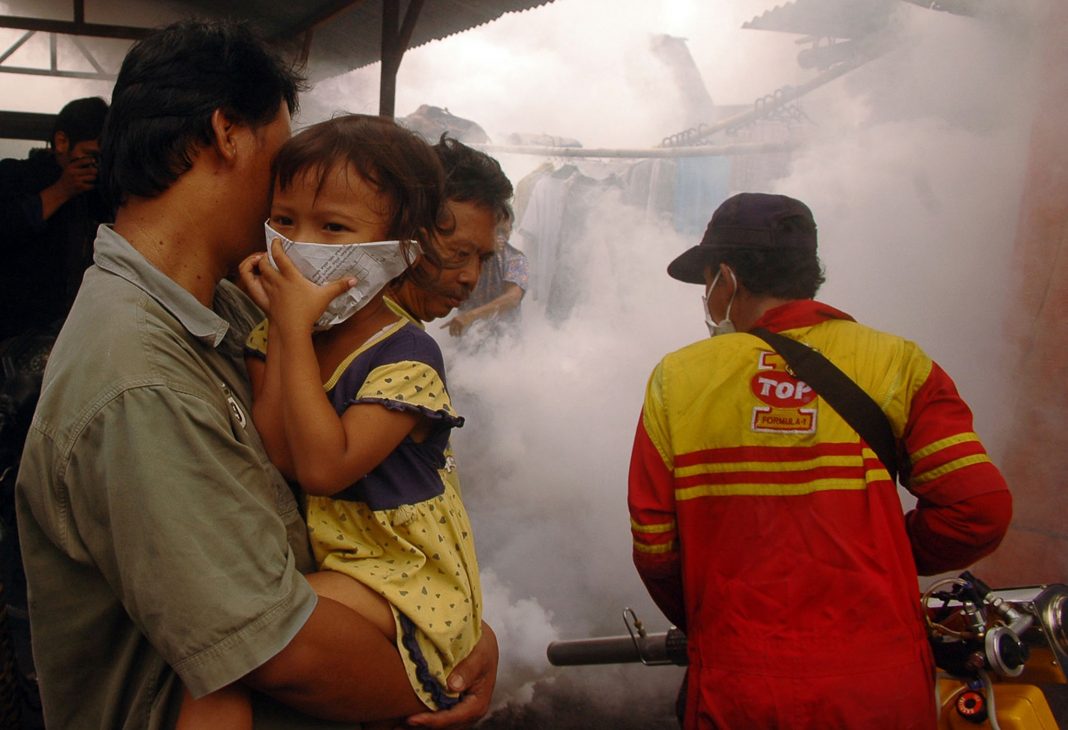During the height of restrictions and workplace closures for COVID-19, dengue cases dropped across 23 countries in Latin America and Southeast Asia
Dengue is a viral infection transmitted by the Aedes species of mosquitoes, causing flu-like symptoms and often, death. It is predominantly found in tropical and sub-tropical climates worldwide, most commonly in urban areas.
The weather, environment and human mobility affects the rate of spread of the infection. Dengue season in many countries is generally around June to September, when peaks in cases can cause overcrowding in hospitals – as seen with cases of COVID-19 also.
COVID-19 measures, including school closures and ‘high-traffic and mixing’ areas had the strongest drop in dengue cases, where almost three quarters of a million fewer global cases of dengue occurred in 2020 – researchers predict this could be linked to COVID-19 disruptions limiting human mobility and contact.
Recording the monthly dengue cases from the World Health Organization (WHO) Weekly, researchers find that across 23 countries – 16 in Latin America and seven in Southeast Asia – found that there were less than 750,000 dengue cases in 2020 than seen in the years before, which they put down to COVID-19 restrictions.
Tactics for new dengue intervention approaches
Published in Lancet Infectious Diseases, researchers took climate data on air temperature, relative humidity and precipitation across Latin America and Southeast Asia – which are the main regions where dengue is prominent.
The analysis found a strong link between school closures and declines in non-residential trips, like shopping or using public transport, due to COVID-19 and reduced risk of dengue transmission. The research highlights that these commonly visited places could be dengue transmission hot spots and play a key role in spreading the disease.
Researchers note that changes in people’s movements can effect transmission rates, as seen through reduced exposure to mosquitoes or fewer opportunities for infected people to go out and about and pass on the virus to uninfected mosquitoes present there.
Dr Oliver Brady, Associate Professor and MRC Fellow at LSHTM and study senior author, said: “Currently dengue control efforts are focused on or around the households of people who get sick.
“We now know that, in some countries, we should also be focusing measures on the locations they recently visited to reduce dengue transmission. For all the harm it has caused, this pandemic has given us an opportunity to inform new interventions and targeting strategies to prevent dengue.”
Dengue is only spread from mosquito to human and vice versa
In April 2020, dengue case numbers suddenly began to decline in in many countries, following the introduction of public health and social measures targeting the spread of COVID-19.
In 2020, dengue cases decreased by 40.2% in Latin America and 58.4% in Southeast Asia, with just over two million cases recorded in the Americas and South East Asia in 2020.
Nevertheless, the impacts of COVID-19 disruption are hard to track, as 2019 saw the largest global dengue outbreak in history, with more than 5.2 million cases recorded in the Americas and Southeast Asia region – which eventually led to high levels of immunity across communities – which would also be expected to reduce dengue cases in 2020.
Dr Brady added: “Before this study, we didn’t know whether COVID-19 disruption could increase or decrease the global burden of dengue. While we could assume reduction in human movement would reduce the virus transmission, it would also disrupt the mosquito control measures already in place. This disruption may result in long-term impacts on dengue cases which might not be evident until the next epidemic.”
The study found that nine out of 11 countries in Central America, the Caribbean and the Philippines saw a complete suppression of their 2020 dengue season.
In countries where the COVID-19 restriction measures began at the peak of dengue season, there was an extremely sharp decline in cases, despite above average incidence being recorded earlier in the year.
However, this decrease in cases could also be attributed to reduced rates in people seeking treatment due to higher rates of admission of COVID-19 cases in the hospitals.
Half the world’s population is at risk of contracting dengue
Despite most cases declining in these areas in 2020, Peru and Singapore reported worse than average dengue incidence in 2020 – researchers put this down to the unpredictable natural year-to-year variation in dengue incidence that occurs due to the emergence of different dengue virus variants, or could hint at the greater role being bitten by mosquitoes at home plays in spreading dengue in these countries.
The researchers note that it remains to be seen how many of the estimated 0.72 million cases were truly averted, or just delayed until later years as human movement returns to pre-COVID levels and say it’s key to continue monitoring dengue trends in 2022 and beyond.
Researchers from this study, involving authors from the London School of Hygiene & Tropical Medicine (LSHTM), Beijing Normal University and other international partners, funded by the Medical Research Council, aim to conduct furthers research into how human movement behaviours – the places people visit, how long they spend there and with whom – impact dengue transmission risk.
This could help decision makers decide if measures like contact tracing, testing or quarantine could help control the spread of the disease.








